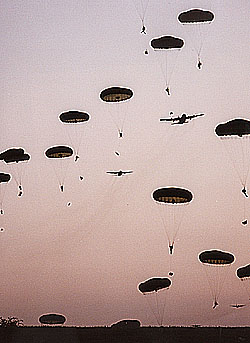
 www.youtube.com/watch?v=93G27U_HdZY
www.youtube.com/watch?v=93G27U_HdZY
USAF and Army studies indicate there are two ways to evade enemy air defenses: drop really low (below 250-500 feet) to evade radar detection or VERY HIGH to evade enemy small arms and missiles if its no longer possible to surprise the enemy. This includes EVERY item of Airborne force equipment under 500 feet, not just Paratroopers. Yet, today's lines-opening-first T-10Dparachutes are not reliable under 500 feet.
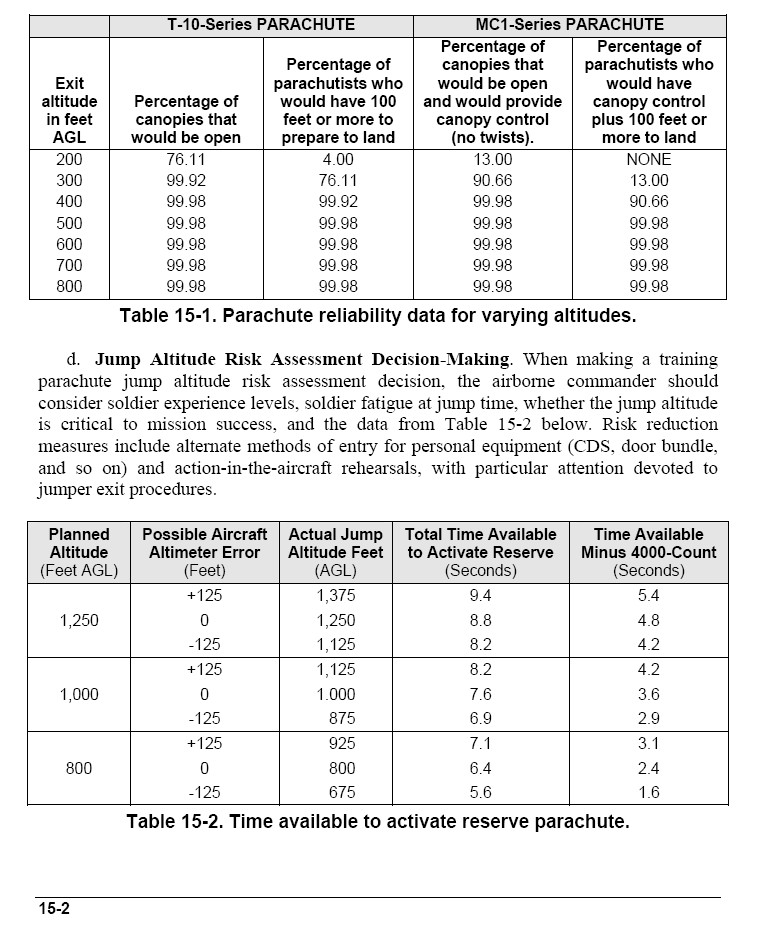
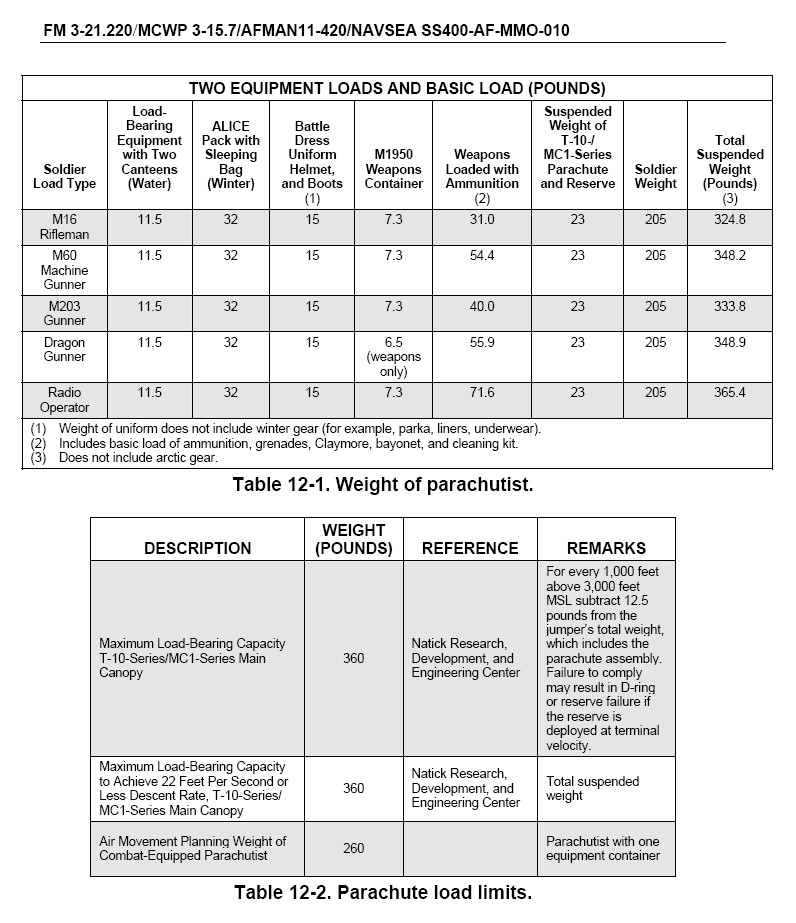
During WWII, American Paratroopers were able to jump at extremely low altitudes due to the T-4/T-7's canopy-and-lines-at-the-same-time opening sequence. The photos below show a French Paratrooper jumping a T-4 or T-7.
1.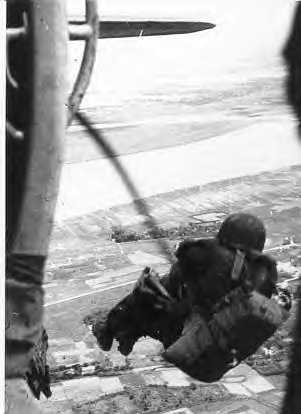
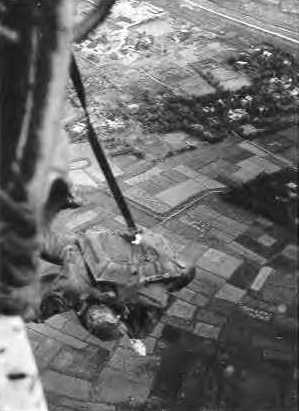
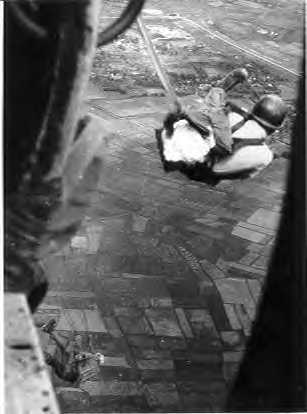

Despite a severe opening shock, the 1940s-50s Paratroopers were able to jump as low as 143 feet in training, and 250 feet in actual combat. This reduced the time under canopy and the wind blowing Paratroopers far apart from each other. I estimate at 250 feet, you would have 3-4 seconds for your canopy to open, then one second to check canopy, if its there you pull on your ruck release tab to lower your rucksack and then snap into a prepare-to-land position---you have 3 seconds before you land. Unlike some, I believe that if you saw no canopy at all above you at the end of your 4 count you could deploy a reserve in time to save your life, but this should be a reserve that's gas cartridge activated and integral to the back, not cluttering the front of the Paratrooper. With the T-10 family we went to the lines-opening first deployment sequence using a deployment bag to hold the canopy as the suspension lines first payed out in order to reduce the opening shock, but we paid for it in ALTITUDE, as you will see in the following pictures/descriptions. First we go into details of how the current T-10 series parachutes are configured and hinder a clean exit from aircraft.
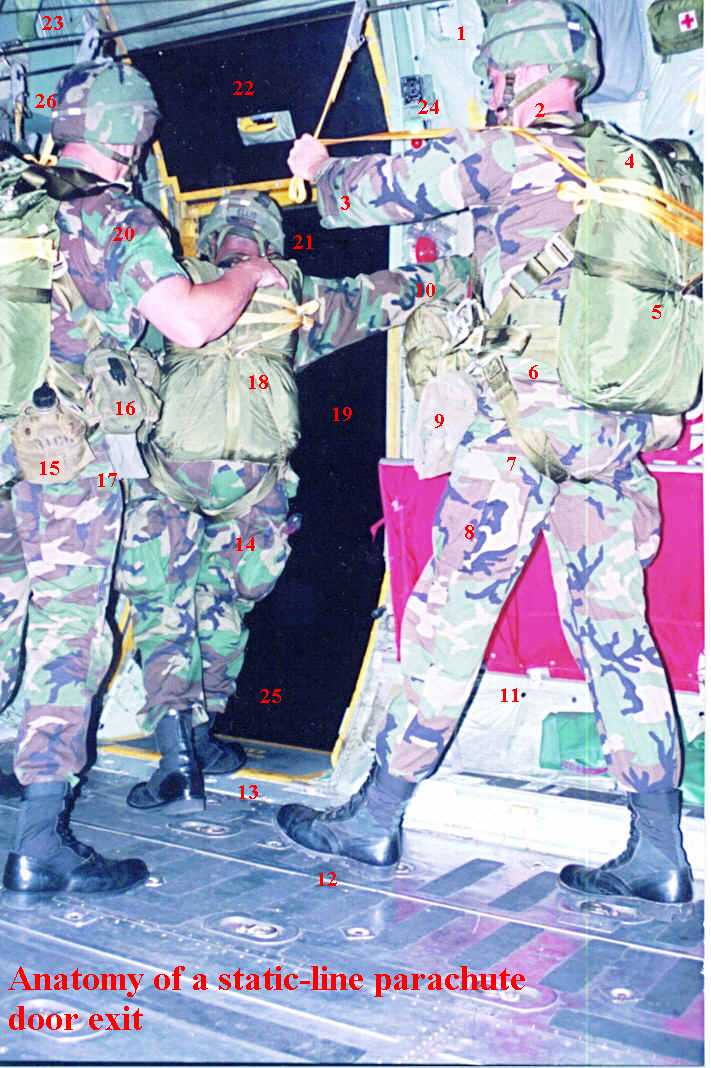
1. C-130 jumper with PASGT Kevlar helmet, needs 550 cord or turtle straps to keep camouflage band from flying off
2. Chinstrap is secured by a weak velcro strap wrapped around under the buckle, the helmet still wobbles and can fall off from opening shock. Needs a better 3-point chinstrap farther forward than the temple.
3. Paratrooper holding a "bight" of his static-line in his left hand, at the "STAND BY" position. He will be the first jumper out the door when the green light goes on. BDU cuffs kept open for better cooling--another snag risk. A lighter BDU is needed to prevent this.
4. 15 foot yellow static line doesn't work well on C-17s, C-47 type aircraft, willbe replaced by 20 foot Universal Static-Line, yet more reason for a better parachute that opens under 250 feet
5. Pack tray holds by 4 flaps the canopy in its deployment bag
6. Waist band to hold the reserve parachute is an obstacle to getting out of the harness in combat or during a water landing--training is incorrect by teaching a one handed pull to undo the quick release fold--under weight suspened under canopy TWO HANDS are needed to undo the waist strap. Obvious solution is GET THE RESERVE OFF THE FRONT! and onto the back co-located with the main parachute.
7. Legs strap saddle are not split, resulting in extreme discomfort after long periods of time with parachute harness on. Split saddle leg straps can solve this on a new parachute.
8. A lightweight kit bag or the newer nylon kit bag should be in the BDU trouser pocket for recovery of the parachute/air items NOT under the reserve hindering harness exit in combat or emergency water landing.
9. Dreaded kit bag under the leg straps! In a pitiful attempt to pad the groin, we clutter the Paratrooper further and risk his death by enemy fire or drowning.
10. D-rings which the snaphooks of the reserve clip onto and are difficult to undo in a stressful situation. The IDF Paras undo the left side of their reserve parachute after lowering their rucksacks--a good technique the U.S. Airborne should employ until a better parachute replaces the current T-10 series that has reserve on the back.
11. Folded up nylon bench seats are now out of favor, C-17-style individual fold up seats are the rave of the Airborne. However if you look to the left, there is no seating where the jump door is open. A bench type seat should slide out to the left to create 2 seats in front of the jump doors adding 4 more jumpers per C-130. These seats would be released and drop to the floor before a jump or in emergency escapes. This simple volume-enhancer would add 4 more jumpers per Hercules, 68 jumpers from the standard 64 we fill now into C-130s.
12. Jumpers are wearing BLACK jungle boots without ankle support--Parachutist Ankle Braces (PABs) should be worn over these for the jump to prevent ankle injuries, then removed on the Drop Zone so the jungle boot's cooling and lightness for field operations is intact.
13. Jump platform outlined in yellow needs red lines showing a 40-45 degree orientation to encourage jumpers to make smooth walking exits with good footwork.
14. Primary Jumpmaster (JM) here looking out the left jump door
15. One quart canteen with shiny metal snaps shows the need for a covered canteen cover/pouch. Landing on the hard plastic one quart canteen can cause injuries and is yet another reason to adopt a softer collapsible Platypus type canteen to fit into the current and improved cover/pouch. The unit has stenciled its name to preclude field loss--a good idea.
16. M16 rifle magazine pouch worn underneath T-10 parachute of non-jumping Safety securing the JM's static-line and packtray, holding him inside the aircraft as he inspects the jump door and looks for the drop zone
17. The infamous grayish-green folded kit bag jutting out from under the leg straps!
18. Above you can see the white 50-pound break cord which closes together the 4 flaps of the pack tray around the d-bag. When the Paratrooper falls away from the aircraft, his static-line will pull tight then break open this tie, unfurling the d-bag and the suspension lines then risers will pay out. If this tie should not break, the jumper will become towed and be either pulled in or cut away. This is a vital inspection item for the JMs during JMPI.
19. The jump doors of the C-130 are only 36 inches wide---why its vital that we de-clutter the Paratrooper to insure a clean exit without touching or snagging the sides of the door.
20. Sleeves rolled-up, Army style? How can this be? You don't want to PLF with your sleeves rolled up. "He ain't jumpin". He's a SAFETY. He has to stay aboard the plane to help the USAF Loadmaster pull in the d-bags and static-lines of those who jumped. If we had a parachute that had the d-bags detach and stay with the canopy, only the static-lines would trail the plane, resulting in less drag and would be easier to pull in by just the USAF Loadmasters. Thus, the two Army Safeties could jump, resulting in 2+ more shooters on the ground below to win the battle for the Airborne and America,
21. The back of the JM's Kevlar PASGT helmet shows the Parachutist foam impact pad and the retention straps that wrap forward and back around the chinstrap under the buckles. He has sewn his last name to the rear of his helmet camouflage cover, a good idea for identification. The two luminous "Cate Eyes" on his camouflage band are also visible.
22. C-130 side Paratrooper jump doors slide up on rollers, a unique way to open the aircraft without getting in the way of the Paratroopers inside if it folded inside
23. The 2 steel anchor line cable which the static-line snap hooks slide along. This is the lifeline of the Paratrooper--as he shuffles to the door, he slides his static line along with his hand holding a bight of it---he hands the bight to the Jumpmaster/Safety, then makes his walking door exit---when he falls away from the aircraft after door exit, the anchor line cables hold the end of the static-line so it extends out to full length and breaks open the pack closing tie. Seconds later, the last tie holding the top of the canopy to the d-bag will "tug" and the static-line as seen from the inside of the plane will go from the bottom of the door up to the top as the d-bag pulls horizontal. A lot of stress is placed on the anchor line cables.
24. The Red and Green lights---the famous signals of when to jump or not to jump. Also note the straight arm holding the static line high over the shoulder to prevent static-line injuries if it gets under the arm pit. The little details in the Parachute jump count!
25. Notice there is a small extension in the air flow provided by the jump platform on the C-130, in the case of the left jump door, you should step off with the right foot and have the airflow turn your body cross ways so you face the rear of the airplane as your parachute opening sequence takes place. If you step off with your left foot the air will catch you and spin you beyond facingto the rear, causing twists. Others say it doesn't matter which foot you step off with. A higher standard of execution would only increase the safety and precision of the Airborne operation.
26. If you look carefully or use NETSCAPE as a browser, you should be able to see the safety wire placed through the static-line snaphook to insure it doesn't get unhooked. Nonsense like forgetting to "hook-up" perpetuated by non-Airborne types like Harold Coyle in his Armor-branch chest-thumper novels are just ignorant people trying to find fault with people who employ a style of warfare that is more demanding. Noone forgets to hook-up and place the safety wire through, closing it shut, and even if someone did, the JMs/Safeties as well as your buddy behind you would insure it gets hooked up/wired closed long before the Paratrooper even gets close to an open jump door.
And one important thing---these Paratroopers are jumping "Hollywood"--no combat equipment--add on rucksacks and M1950 weapons cases and you have a very cluttered arrangement and struggle to the jump doors!
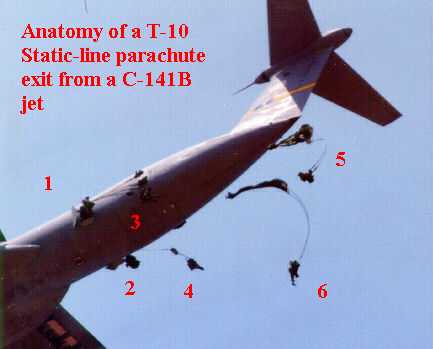
1. Left door jumper stepping off from C-141B jump platform. He is shielded by a large air deflector with "swiss cheese" type holes. Its critical that he be in a tight body position as he exits to create a "knife edge" for the air flow to not catch and spin him around. At this point he is unfettered by the jet blast. You can see the previous jumper's static-lines and deployment bags streaming out the door horizontal and high up on the door. The D-bag catches air and creates drag on the airplane, making it difficult to pull them in after a pass over the drop zone. Thus, the number of jumpers per anchor line cable is limited to less than the seating capacity of the plane. Worse yet, 2 x Army Jumpmaster acting as the "Safeties" DO NOT JUMP TO THE BATTLE BELOW and stay to help the USAF Loadmasters pull the static-lines and d-bags into the plane! Some foreign parachutes have d-bags detach with the parachute, leaving only static lines trailing out the plane for max jumper capacity and faster exits from the drop zone by delivery aircraft. The sooner the jump doors are closed, the sooner the plane can throttle up to full speed to exit the area.
2. The right door jumper is already stepping out into space, his rucksack low on his legs catching air first followed by the rest of his body. He MUST be in a tight body position as he instantly drops from the aircraft's altitude the 15 soon to be 20 feet with the new Universal Static Line to pull his static line tight and have it open the 50-pound breakaway cotton cord holding his parachute pack tray closed. The door exit is key to a good opening canopy sequence---this is why we must remove the gear cluttering the Paratrooper's body so he can better gain this attitude in the air.
3. Jumper #3 is floating away more sideways than down, his packtray has just been opened and you can see his d-bag pulling out from his back as the suspension lines pay out. The canopy itself is still in the d-bag.
4. On the other side, Jumper #4 is farther along with his suspension lines about 1/3d of the way out
5 & 6. Once ALL the suspension lines and risers are off/out from the d-bag, the fun begins. You can see the two sets of risers on Jumper #5. Ties holding the canopy are broken, and the canopy starts coming out of the d-bag pulled by the weight of the Paratrooper. Once the canopy is fully elongated, the ties at the apex break from the d-bag; the canopy is held at the top for a brief split-second "yank" that creates the curved arc shape seen in the picture. The d-bag flops up and stays with the aircraft flying away at 150+ mph. The Paratrooper is about 40 feet below the aircraft, as he is thrown forward by the travel of the aircraft during the opening sequence. His canopy will now rapidly fill with air, which will catch and turn him sideways, and then "teacup" to an upright position. This taking place under 4 seconds time. The jumper reciting a 4 second count, if he doesn't see a full canopy over his head will deploy his reserve parachute as he has already lost 50-100 feet of altitude.
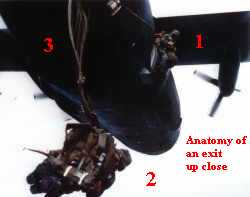
2. What's humorous about this jumper is that he hasn't secured the bottom of his ALICE rucksack to a leg--it has been lifted by the airstream and flopped up into his face. He has a good tight body position, otherwise. this is exactly why we went to the Harness Single Point Release (HSPR) system to keep rucksacks tight to the body. However, a better solution would be to get rid of the chest mounted reserve and get the ruck off the legs.
3. His risers and suspension lines are all extended, they have not snagged on him or any of his equipment, his canopy is elongating. Soon, he will be pulled back from the plane by the open canopy, cut from the d-bag/static-line still connected to the plane. He is facing away from the plane and cannot see it---he is sideways from the airflow's power---a good exit---bad rucksack rigging.

Why its important to have a clean, smooth exit:
1. Jumper with twisted lines, you can see him bicycling his legs to undo the twist.
2. Jumper with twisted lines
3. Jumper with severely twisted lines, could be in trouble, body seems sideways, as if some suspension lines got caught on his equipment. He does have a fully open canopy.
4. Notice the canopies opening under the aircraft at about 50-100 feet, yet upon opening they seem to rise a bit. Both sticks, left and right door converge at the tail into a single stream, which is why Jumpmasters are careful to stagger door exits to reduce risks of collisions. The two lowermost canopies are still filling up with air.
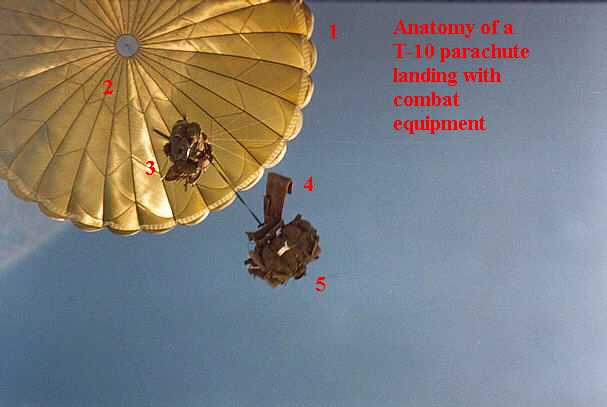
1. A beautiful shot looking up at a Paratrooper coming down! The edge of his canopy shows the white anti-inversion netting and the air billowing out each gore panel.
2. At the top opening or apex, air escapes to prevent the canopy from oscillating from trapped air having no place to go. While the "C" model's nylon fabric is transluscent, its not letting any air through, lowering the descent rate of the Paratrooper. Older "B" model parachutes are not made of zero-porosity fabric and descend at a faster rate.
3. The skilled Paratrooper has his feet/knees together ready to PLF (Parachute Landing Fall), perhaps his knees even a little too bent, resulting in a feet/butt landing.
4. He has released his M1950 weapons case holding his M16 5.56mm rifle sliding it onto his Large ALICE rucksack dangling on the Hook, Pile Tape Lowering Line (HPT LL). The field pack is the A.L.I.C.E. pack (Large) and has an external frame. In the photo, the Super Artcic Paratrooper is using the single point release equipment harness, still used today. The battalion policy was to lower your weapon with your ruck during training operations. A lot of people were riding their weapon in (which common sense says you should in combat) doing left PLF's and bending their barrels. So, the CG made a "blanket policy" that we were to lower the 1950s with our ruck during training. We're not sure if the unit still does it, or if other units do it also. The M1950 case is padded enough to stay by his side during the PLF and neither damage the weapon or the Paratrooper so he can get it and return fire on the enemey ASAP. With the advent of the shorter M4 5.56mm Carbine, the Paratrooper can jump with it slung over his shoulder with tape/padding added, making the M1950 weapons case completely un-necessary for the rifleman. The more we can streamline the Paratrooper, the better his exits will be at the jump door, resulting in good landings and combat power on the ground for the U.S. Airborne.
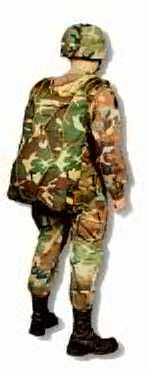
The good news is that the Advanced Tactical Parachute System (ATPS) will have the reserve parachute off the chest and on the back, dramatically reducing the jumper clutter. The rucksack held high off the legs will also reduce clumbsiness shuffling to the jump door as well as reducing the size of the jumper in the airstream to reduce spinning.
Unfortunately, the Army reportedly wants the next ATPS parachute to descend from the same heights we jump now:
"The ATPS will serve the same combat environment as the T-10: 500 ft AGL minimum planned altitude deployed from aircraft traveling at speeds of 130-150 Knots."
Earlier the January 1996 Natick Warrior written newsletter reported the ATPS would descend at a very fast rate then just prior to impact, an air bag type device would pull on the risers and let go to give a burst of lift before hitting the ground. This is a bad approach because it ignores the central concern is having the AIRPLANES themselves stay under enemy radar detection altitude, not the mythical fears of being shot while under canopy. Jump aircraft will have to pop up to 500 feet to drop Paratroopers, revealing their insertion location. The solution is to JUMP LOWER WITH BETTER PARACHUTES. The following are 2 such parachutes that can be bought "off-the-shelf" and integrated into a streamlined, T-21 piggyback parachute container to declutter the Paratrooper like the ATPS. The ATPS is a giant step in the right direction, we hope it is fielded with a very low-level parachute instead of a standard level parachute with rapidly brakes.
Unlike NATO parachutes, Russians parachutes do not have static lines or D-bags that hang out of the jump doors, slowing down the airplane and requiring two or more people to pull them in. The Russian D5/6 parachute has a drogue stabilizer chute, which is deployed when the Paratrooper exits the door. As he falls away from the airplane stabilized, he can deploy the main chute with a rip cord pull or by an automatic opening device. He can jump from aircraft much faster, up to 250 mph, at high altitudes using the delay-opening feature. He can jump in front of the aircraft's engine so his BMD AFV can exit the rear ramp, by simultaneously exiting from both jump doors and the BMDs over the rear ramp. Russian Paratroopers land closer together than the American system of having a separate heavy drop zone for vehicles and a personal drop zone for Paratroopers. At the very least the next U.S. Parachute should have its D-bag detached and stay with the canopy if we do not go all the way and adopt the Russians stabilizer chute.

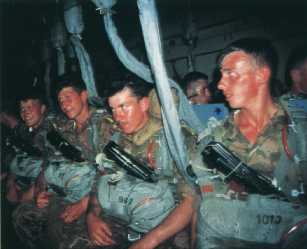

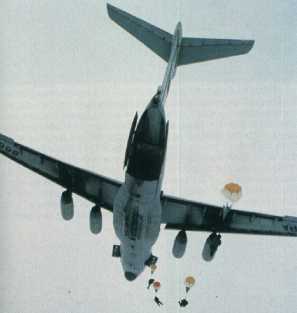
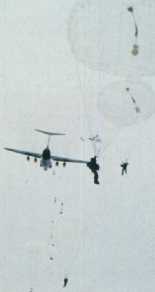
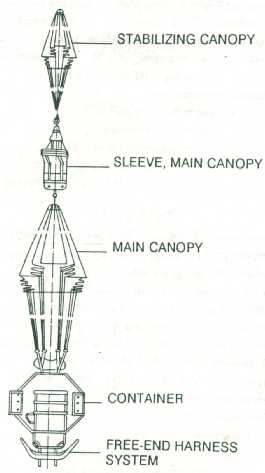
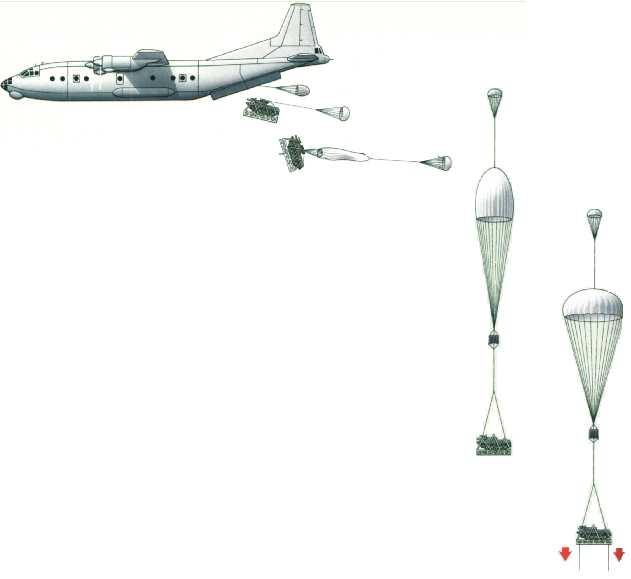
The Russians do have some static-line parachutes for very low jumps--here's a 300 foot jump from an AN-2 "Colt"
Irvin CT-5000
LLP
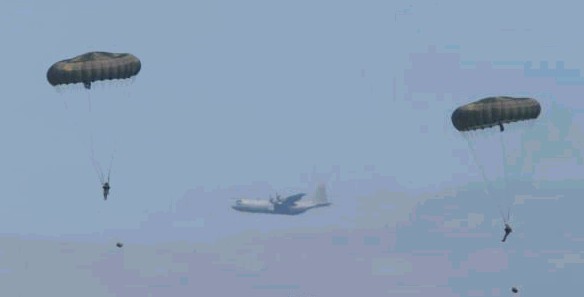
FROM THE OUTSIDE
www.youtube.com/watch?v=Of4E-2fSeWs
FROM THE JUMPER'S PERSPECTIVE
www.youtube.com/watch?v=yAjNop4uyao
Francis Tusa writes in the Armed Forces Journal International, October 1993 issue, page 24 article "The Cinderella of UK Land Forces fights for resources":
"Some equipment improvements are in store for 5 Airborne. The first is a new low-level parachute. Brig. Holmes was bullish about this item of equipment: 'The new Irvin parachute is a world beating system. We will come down to a training height of 650 feet and an operational height of 250 feet. This is a quantum leap in terms of parachuting capability, no longer having to have C-130s popping-up to drop troops'. The new parachute was slated for introduction last month, with a full battalion to be equipped by early 1994"."Eight parachutists are to attempt a unique, low-altitude descent in September. They will leap from an altitude of just 75 metres--lower than Big Ben but higher than Nelson's Column.
The jump, by the parachute test team at Britain's Defence Evaluation Research Agency (DERA) in Boscombe Down, Wiltshire, will cap a decade of work trying to create a parachute that allows Paratroopers to descend safely from aircraft flying below the gaze of enemy radar.
Although special stunt parachutes exist for the sport of "base jumping", in which daredevils leap from tall buildings, these are aerodynamically unsuitable for military parachute drops.
The new parachutes are made from the same heavy-duty nylon as conventional military chutes. But instead of the usual "dome" shape, they look more like jellyfish, with tucked-in rims, and they capture air more effectively.
So far, Paratroopers have made more than 15,000 test jumps with the new parachutes, but none from altitudes lower than 250 metres. September's drop will be the acid test for the design. "From exit to full inflation takes around 4 seconds," says Mark Smith, squadron leader of DERA's parachute test team. That will leave around 30 metres of descent with a full canopy in the 75-metre drop.
The entire descent is expected to take 10 seconds. To avoid the possibility of serious injury, Smith and his colleagues will make the drop over a lake in the south of France.
Smith says the project is being watched closely by the world's armed forces. "There's considerable international interest in this trial," he says.
The most recent low-level combat jump using military parachutes was from around 130 metres, when U.S. Paratroops invaded the Caribbean island of Grenada in 1983.
KEY FEATURES:
|
Configuration |
Central conical top cap suspended above a conical extended 24 Gore Annular Main Chute |
|
Size |
40 Ft. Dia (nominal) |
|
Weight |
23.0 lbs. (Canopy & Risers) |
|
Volume |
Hand packs into T-10/CT-1 AD@ Bag |
|
Fabric |
Nylon |
|
Modular Construction |
Top cap, annular main and all rigging lines joined by larkshead knots for ease of maintenance |
|
Inflation |
Tailored to reduce opening shock, minimize swing through and stabilze quickly |
|
Stability |
Plus or minus 5 degrees |
|
Descent Rate |
18.5 Ft/sec nominal with 360 lbs. All up weight |
|
Deployment Speed |
150 KEAS - maximum |
|
Descent Control |
No Inherent Drive - Riser pull down provides ability to accurately and quickly turn and side slip canopy into wind which enables jumper orientation for safe landing. |
IRVIN INDUSTRIES CANADA LTD.
|
PO Box 280 |
PO Box 1163 |
Irvin Aerospace |
|
Fax # (416) 871-6534 |
Email Address: howard@irvingrp.com |
Pioneer Aerospace Rapid-Opening Low-Altitude Parachute 8200
ROLAP Tactical Assault Personnel Parachute (TPP)

The ROLAP 8200 canopy is of the large, new generation type.
It has a parabolic design and is made of zero porosity nylon fabric, thus providing a very low rate of descent.
The peripheral air intakes, as well as the general performance of the canopy, ensure consistent, rapid openings.
The design of the ROLAP 8200 troop back parachute canopy includes four large vents and four small vents. These vents provide the parachutist with maximum stability at any weight during descent.
The two control lines and their corresponding handles allow the user to rotate the canopy around its vertical axis and to reduce the effect of wind drift upon landing.
|
Operational drop altitude |
400 ft. AGL |
|
Technical minimum drop altitude |
250 ft AGL |
|
Operating Speed |
130 - 150 KIAS |
|
Max. Gross weight |
360 lbs |
|
Max. Drop zone elevation |
20,000 ft. AMSL |
|
Continuous drive |
No |
|
Max. Groound wind speed |
20 Kts |
|
Rotation capability |
Yes |
|
Max. Opening shock |
8 G=s |
|
Rate of descent at sea level/350 lbs |
18 ft/sec |
|
Stability (average oscillation) |
Less than 10degree from vertical |
|
Reliability |
99.998% |
|
Life Span |
120 jumps or 15 years |
Technical Characteristics
|
Shape |
Parabolic |
|
Nominal diameter |
38ft |
|
Nr of gores |
28 |
|
Canopy fabric |
Zero porosity |
A Zodiac Company
250 East Drive
Suite G
Melbourne, FL 32904
(407) 676-4604
Fax # (407) 676-4661